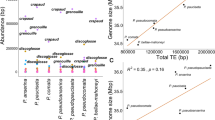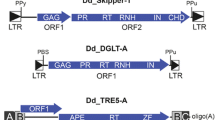Abstract
The availability of the complete genome sequence of cerevisiae provides the unique opportunity to study an entire genomic complement of retrotransposons from an evolutionary perspective. There are five families of yeast retrotransposons, Ty1-Ty5. We have conducted a series of comparative sequence analyses within and among S. cerevisiae Ty families in an effort to document the evolutionary forces that have shaped element variation. Our results indicate that within families Ty elements vary little in terms of both size and sequence. Furthermore, intra-element 5′–3′long terminal repeat (LTR) sequence comparisons indicate that almost all Ty elements in the genome have recently transposed. For each family, solo LTR sequences generated by intra-element recombination far outnumber full length insertions. Taken together, these results suggest a rapid genomic turnover of S. cerevisiae Ty elements. The closely related Ty1 and Ty2 are the most numerous elements in the genome. Phylogenetic analysis of full length insertions reveals that reverse transcriptase mediated recombination between Ty1 and Ty2 elements has generated a number of hybrid Ty1/2 elements. These hybrid Ty1/2 elements have similar genomic structures with chimeric LTRs and chimeric TYB (pol) genes. Analysis of the levels of nonsynonymous (Ka) and synonymous (Ks) nucleotide variation indicates that Ty1 and Ty2 coding regions have been subject to strong negative (purifying) selection. Distribution of Ka and Ks on Ty1, Ty2 and Ty1/2 phylogenies reveals evidence of negative selection on both internal and external branches. This pattern of variation suggests that the majority of full length Ty1, Ty2 and Ty1/2 insertions represent active or recently active element lineages and is consistent with a high level of genomic turnover. The evolutionary dynamics of S. cerevisae Ty elements uncovered by our analyses are discussed with respect to selection among elements and the interaction between the elements and their host genome.
Similar content being viewed by others
References
Abbott, A., J. Abu-Threideh, C. Ahrens, R. Ainscough, E. Alexander et al., 1998. Genome sequence of the nematode C. elegans: a platform for investigating biology. Science 282: 2012–2018.
Arkhipova, I.R., A.M. Mazo, V.A. Cherkasova, T.V. Gorelova, N.G. Schuppe et al., 1986. The steps of reverse transcription of Drosophila mobile dispersed genetic elements and U3-R-U5 structure of their LTRs. Cell 44: 555–563.
Blattner, F.R., G. Plunkett, III, C.A. Bloch, N.T. Perna, V. Burland et al., 1997. The complete genome sequence of Escherichia coli K-12. Science 277: 1453–1474.
Boeke, J.D., 1989. Transposable elements in Saccharomyces cerevisiae, pp. 335–374 in Mobile DNA, edited by D.E. Berg and M.M. Howe. American Society for Microbiology, Washington, DC.
Boeke, J.D., D. Eichinger, D. Castrillon & G.R. Fink, 1988. The Saccharomyces cerevisiae genome contains functional and nonfunctional copies of transposon Ty1. Mol. Cell. Biol. 8: 1432–1442.
Boeke, J.D., D.J. Garfinkel, C.A. Styles & G.R. Fink, 1985. Ty elements transpose through an RNA intermediate. Cell 40: 491–500.
Clare, J. & P. Farabaugh, 1985. Nucleotide sequence of a yeast Ty element: evidence for an unusual mechanism of gene expression. Proc. Natl. Acad. Sci. USA 82: 2829–2833.
Fink, G.R., J.D. Boeke & D.J. Garfinkel, 1986. The mechanism and consequences of retrotransposition. Trends Genet. 2: 118–123.
Fleischmann, R.D., M.D. Adams, O. White, R.A. Clayton, E.F. Kirkness et al., 1995. Whole-genome random sequencing and assembly of Haemophilus influenzae Rd. Science 269: 496–512.
Goffeau, A., B.G. Barrell, H. Bussey, R.W. Davis, B. Dujon et al., 1996. Life with 6000 genes. Science 274: 546, 547–563.
Hani, J. & H. Feldmann, 1998. tRNA genes and retroelements in the yeast genome. Nucleic Acids Res. 26: 689–696.
Jordan, I.K. & J.F. McDonald, 1998. Evidence for the role of recombination in the regulatory evolution of Saccharomyces cerevisiae Ty elements. J. Mol. Evol. 47: 14–20.
Jordan, I.K. & J.F. McDonald, 1999a. Phylogenetic perspective reveals abundant Ty1/Ty2 hybrid elements in the Saccharomyces cerevisiae genome. Mol. Biol. Evol. 16: 419–422.
Jordan, I.K. & J.F. McDonald, 1999b. The role of interelement selection in Saccharomyces cerevisiae Ty element evolution. J. Mol. Evol. 49: 352–357.
Jordan, I.K. & J.F. McDonald, 1999c. Tempo and mode of Ty element evolution in Saccharomyces cerevisiae. Genetics 151: 1341–1351.
Kim, J.M., S. Vanguri, J.D. Boeke, A. Gabriel & D.F. Voytas, 1998. Transposable elements and genome organization: a comprehensive survey of retrotransposons revealed by the complete Saccharomyces cerevisiae genome sequence. Genome Res. 8: 464–478.
Koonin, E.V., A.R. Mushegian, M.Y. Galperin & D.R. Walker, 1997. Comparison of archaeal and bacterial genomes: computer analysis of protein sequences predicts novel functions and suggests a chimeric origin for the archaea. Mol. Microbiol. 25: 619–637.
Matyunina, L.V., I.K. Jordan & J.F. McDonald, 1996. Naturally occurring variation in copia expression is due to both element (cis) and host (trans) regulatory variation. Proc. Natl. Acad. Sci. USA 93: 7097–7102.
McDonald, J.F., L.V. Matyunina, S. Wilson, I.K. Jordan, N.J. Bowen et al., 1997. LTR retrotransposons and the evolution of eukaryotic enhancers. Genetica 100: 3–13.
Petrov, D.A. & D.L. Hartl, 1997. Trash DNA is what gets thrown away: high rate of DNA loss in Drosophila. Gene 205: 279–289.
Petrov, D.A. & D.L. Hartl, 1998. High rate of DNA loss in the Drosophila melanogaster and Drosophila virilis species groups. Mol. Biol. Evol. 15: 293–302.
Petrov, D.A., E.R. Lozovskaya & D.L. Hartl, 1996. High intrinsic rate of DNA loss in Drosophila. Nature 384: 346–349.
Promislow, D.E., I.K. Jordan & J.F. McDonald, 1999. Genomic demography: a life-history analysis of transposable element evolution. Proc. R. Soc. Lond. B Biol. Sci. 266: 1555–1560.
Rivera, M.C., R. Jain, J.E. Moore & J.A. Lake, 1998. Genomic evidence for two functionally distinct gene classes. Proc. Natl. Acad. Sci. USA 95: 6239–6244.
Sandmeyer, S., 1998. Targeting transposition: at home in the genome. Genome Res. 8: 416–418.
SanMiguel, P., A. Tikhonov, Y.K. Jin, N. Motchoulskaia, D. Zakharov et al., 1996. Nested retrotransposons in the intergenic regions of the maize genome. Science 274: 765–768.
Smit, A.F., 1996. The origin of interspersed repeats in the human genome. Curr. Opin. Genet. Dev. 6: 743–748.
Tatusov, R.L., E.V. Koonin & D.J. Lipman, 1997. A genomic perspective on protein families. Science 278: 631–637.
Voytas, D.F. & J.D. Boeke, 1992. Yeast retrotransposon revealed. Nature 358: 717.
Voytas, D.F. & J.D. Boeke, 1993. Yeast retrotransposons and tRNAs. Trends Genet. 9: 421–427.
Wickner, R.B., 1996. Viruses of yeast, fungi & parasitic microorganisms, pp. 425–453 in Fundamental Virology, edited by B.N. Fields, D.M. Knipe and P.M. Howley. Lippincott-Raven Publishers, Philadelphia.
Author information
Authors and Affiliations
Rights and permissions
About this article
Cite this article
Jordan, I.K., McDonald, J.F. Comparative genomics and evolutionary dynamics of Saccharomyces cerevisiae Ty elements. Genetica 107, 3–13 (1999). https://doi.org/10.1023/A:1004022704701
Issue Date:
DOI: https://doi.org/10.1023/A:1004022704701




